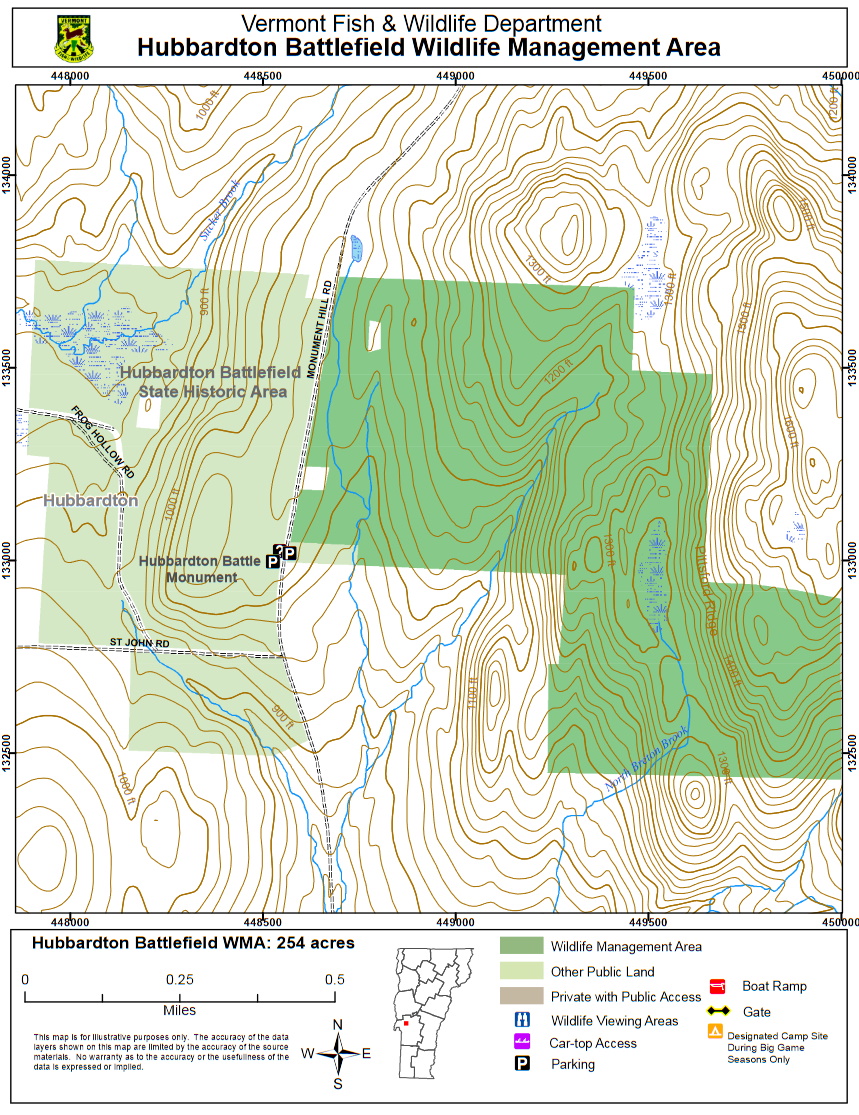Hubbardton Battlefield WMA and State Historic Site
Hubbardton Battlefield WMA and State Historic Site
Hubbardton, Vermont 05735
Hubbardton Wildlife Battlefield Wildlife Management Area guide and mapHubbardton Battlefield State Historic Site webpage
Birds of Interest
During migration, woodcock concentrate in the alders and other shrubs on the property. Large open areas are used by the males for their courting displays in the springtime. The old fields and early successional habitat provide plenty of food for ruffed grouse. Abundant food resources attract turkeys to the area; they are commonly seen on the WMA. The diversity of open habitats and mixed forests allows for a variety of songbird species.
About this Location
Hubbardton Battlefield Wildlife Management Area (WMA) is a 254.5-acre parcel of land owned by the State of Vermont and managed by the Vermont Fish and Wildlife Department. It is located in East Hubbardton, about 7 miles north of Route 4. The WMA is on the east side of Monument Hill Road adjacent to Hubbardton Battlefield, one of the State Historic Sites, which is administered by the Vermont Division for Historic Preservation.
Hubbardton Battlefield WMA is open to regulated hunting, trapping, hiking, and wildlife viewing.
Hubbardton was the site of the only battle fought on Vermont soil during the Revolutionary War. The battle took place on July 7, 1777, between American rear guard troops and the British and German military. The Pittsford Ridge played a prominent role in the battle and is located on the WMA. Please note that it is illegal to remove any historical artifacts. According to the book, “The Battle of Hubbardton: The American Rebels Stem the Tide” by John Williams, Pittsford Ridge was the site where British Grenadiers effectively blocked the Americans’ retreat southeastward along the Castleton Road. This forced the Americans to attempt their retreat by scrambling up the side of the steep Pittsford Ridge, but the British grenadiers beat them to the summit. The American commander Colonel Francis was killed while trying to ascend Pittsford Ridge. Many men in addition to Colonel Francis were killed along the ridge. Those who did manage to escape were not pursued further. For more information on the Hubbardton battle, please visit the visitors’ center at the Hubbardton Battlefield State Historic Site, or read “The Battle of Hubbardton: The American Rebels Stem the Tide” by John Williams. It can be found on the web at https://www.goa.cet.middlebury.edu/ mcgill/battle/index.html. The Vermont Fish and Wildlife Department purchased the land for the WMA in 1970 from George and Ruth
Hubbardton Battlefield WMA consists of a series of ridges and open fields. The ridges, including the famous Pittsford Ridge, are covered with a mix of red oak, red and sugar maple, and hophornbeam. These ridges offer visitors the chance to view something different at the crest of each, such as a scenic vista or a flock of turkeys. Yellow birch, beech, and hickory are also found on the WMA. At the height of the land, a wetland forms a bowl that provides habitats for amphibians. A small vernal pool located on top of the ridge is vital to some species of amphibians. In the lower elevations, old fields have an abundance of apple trees, which are maintained as a food supply for wildlife. White pines are slowly encroaching, and management activities are directed at keeping the fields semi-open. In addition to the apple trees, oak and the occasional beech trees in the area provide an important source of food for many species of wildlife. Hophornbeam drops its seeds later in the year in November and December, providing turkeys with much-needed provisions when other foods are less abundant.
Features
Restrooms on site
Wheelchair accessible trail
Entrance fee
Content from Hubbardton Wildlife Battlefield Wildlife Management Area guide and map
Last updated December 3, 2023
